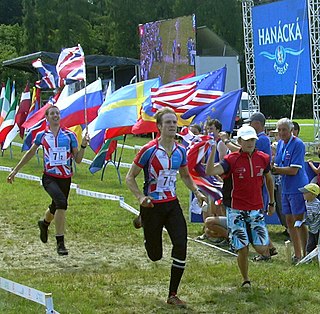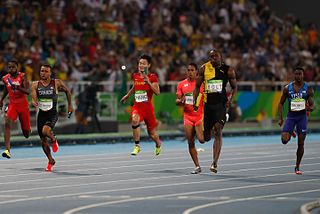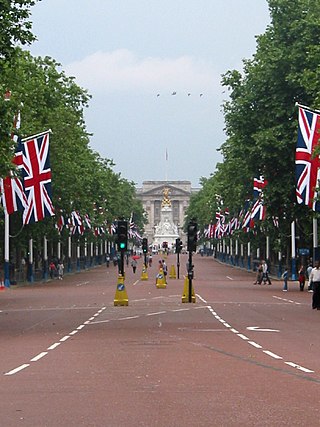Related Research Articles
The Olympic flame is a symbol used in the Olympic movement. It is also a symbol of continuity between ancient and modern games. Several months before the Olympic Games, the Olympic flame is lit at Olympia, Greece. This ceremony starts the Olympic torch relay, which formally ends with the lighting of the Olympic cauldron during the opening ceremony of the Olympic Games. The flame then continues to burn in the cauldron for the duration of the Games, until it is extinguished during the Olympic closing ceremony.

A relay race is a racing competition where members of a team take turns completing parts of racecourse or performing a certain action. Relay races take the form of professional races and amateur games. Relay races are common in running, orienteering, swimming, cross-country skiing, biathlon, or ice skating. In the Olympic Games, there are several types of relay races that are part of track and field. Relay race, also called Relay, is a track-and-field sport consisting of a set number of stages (legs), usually four, each leg run by different members of a team. The runner finishing one leg is usually required to pass the next runner a stick-like object known as a "baton" while both are running in a marked exchange zone. In most relays, team members cover equal distances: Olympic events for both men and women are the 400-metre and 1,600-metre relays. Some non-Olympic relays are held at distances of 800 m, 3,200 m, and 6,000 m. In the less frequently run medley relays, however, the athletes cover different distances in a prescribed order—as in a sprint medley of 200, 200, 400, 800 metres or a distance medley of 1,200, 400, 800, 1,600 metres.

The 4 × 100 metres relay or sprint relay is an athletics track event run in lanes over one lap of the track with four runners completing 100 metres each. The first runners must begin in the same stagger as for the individual 400 m race. Each runner carries a relay baton. Before 2018, the baton had to be passed within a 20 m changeover box, preceded by a 10-metre acceleration zone. With a rule change effective November 1, 2017, that zone was modified to include the acceleration zone as part of the passing zone, making the entire zone 30 metres in length. The outgoing runner cannot touch the baton until it has entered the zone, and the incoming runner cannot touch it after it has left the zone. The zone is usually marked in yellow, frequently using lines, triangles or chevrons. While the rule book specifies the exact positioning of the marks, the colours and style are only "recommended". While most legacy tracks will still have the older markings, the rule change still uses existing marks. Not all governing body jurisdictions have adopted the rule change.

The Queen's Baton Relay is a relay around the world held prior to the beginning of the Commonwealth Games. The Baton carries a message from the Head of the Commonwealth, currently King Charles III. The Relay traditionally begins at Buckingham Palace in London as a part of the city's Commonwealth Day festivities. The King entrusts the baton to the first relay runner. At the Opening Ceremony of the Games, the final relay runner hands the torch back to the King or his representative, who reads the message aloud to officially open the Games. The Queen's Baton Relay is similar to the Olympic Torch Relay. As a result of Queen Elizabeth II's death on 8 September 2022, the Baton Relay could be renamed after her successor, King Charles III, for the 2026 Commonwealth Games.

The 2008 Summer Olympics torch relay was run from March 24 until August 8, 2008, prior to the 2008 Summer Olympics, with the theme of "one world, one dream". Plans for the relay were announced on April 26, 2007, in Beijing, China. The relay, also called by the organizers as the "Journey of Harmony", lasted 129 days and carried the torch 137,000 km (85,000 mi) – the longest distance of any Olympic torch relay since the tradition was started ahead of the 1936 Summer Olympics.
The 1956 Olympic flame hoax was a hoax during the 1956 Summer Olympics, in which Barry Larkin, a veterinary student from Melbourne, ran with a homemade torch and fooled spectators, including a police escort and the Lord Mayor of Sydney, into thinking he was the torchbearer of the Olympic flame.

The 2012 Olympic Marathon Course is that of both the men's and women's marathon races at the 2012 Olympic and Paralympic Games in London.

The 2012 Summer Olympics torch relay was run from 19 May until 27 July, prior to the London 2012 Summer Olympics. The torch bearer selection process was announced on 18 May 2011.

The 2012 Summer Paralympics torch relay ran from 22 to 29 August 2012, prior to the 2012 Summer Paralympics. The relay began with four flames kindled on the highest peaks of the four nations of the United Kingdom, which were then brought to their respective capital cities for special events honouring the upcoming Games. For the relay proper, the four national flames were united at a ceremony in Stoke Mandeville in preparation for a final 92-mile (148-kilometre) journey to London.
The 1948 Summer Olympics torch relay was run from 17 July until 29 July 1948, prior to the 1948 Summer Olympics, held in London, United Kingdom. The relay was nicknamed the "relay of peace". It was only the second occasion that a torch relay was held for the Olympics; the first was at the 1936 Summer Olympics.
The 1936 Summer Olympics torch relay was the first of its kind, following on from the reintroduction of the Olympic Flame at the 1928 Games. It pioneered the modern convention of moving the flame via a relay system from Greece to the Olympic venue. Leni Riefenstahl filmed the relay for the award-winning but controversial 1938 film Olympia.
Though the whole event was eventually cancelled due to the outbreak of war, the 1940 Summer Olympics torch relay was planned for both of the proposed host cities. The International Olympic Committee (IOC) awarded the 1940 Summer Olympics to Tokyo, Japan in July 1936. Tokyo's ability to host the event was questioned after war broke out with China with some countries calling for the Games to be boycotted. The Japanese decided to cancel the event and Helsinki, Finland, the runner-up city in the bidding process, was selected as the replacement. That too was cancelled after the outbreak of World War II.
The 1976 Summer Olympics torch relay celebrated the first time that a Canadian city had hosted the Games. Convention states that the flame should be lit at Olympia in Greece and then transported to Athens, making its way onwards to the host city. On this occasion a signal was sent via satellite to transmit the flame to Ottawa where it would then make its way to the 1976 Summer Olympics opening ceremony in Montreal and a second ceremony in Kingston, Ontario.

Episode 4466 of the BBC soap opera EastEnders was broadcast on BBC One on 23 July 2012, between 9pm and 9.30pm. It was written by Matt Evans, directed by Clive Arnold, and executively produced by Lorraine Newman. It included seven minutes of live footage, during which the character of Billy Mitchell, played by Perry Fenwick, carried the Olympic Torch as an official torch bearer as part of the official torch relay for the London 2012 Olympic Games, and Lola Pearce, played by Danielle Harold, gave birth to her daughter. The storyline for the episode was announced in November 2011, with the fact that Lola would give birth being reported in July 2012. The episode received positive reviews, with Karen Edwards from Heat calling it "special" and praising Harold's performance, and Jane Rackham from the Radio Times calling it "highly topical", though Boyd Hilton from Heat felt that Billy's torch bearing was a "gimmick" and the whole episode should have been live. It was watched by an average of 7.32 million people on its initial broadcast. It was accompanied by a special, one-off BBC Red Button episode called "Billy's Olympic Nightmare". The episode received an All About Soap award nomination for Best Episode, under the name "Billy and the Olympic Torch", and a British Soap Award nomination for "Spectacular Scene of the Year", both in 2013.
The 1968 Summer Olympics torch relay took part as part of the build-up to the 1968 Summer Olympics hosted in Mexico City, Mexico. The Olympic flame was lit in Olympia, Greece, and retraced the steps of Christopher Columbus, discoverer of the New World. This theme celebrated the link between Latin-American and Mediterranean civilizations.
Cathy Birchall was a long-distance motorcyclist credited as the first blind woman to circumnavigate the world.

The 1996 Summer Olympics torch relay was run from April 27, 1996, until July 19, 1996, prior to the 1996 Summer Olympics in Atlanta. The route covered 26,875 kilometers (16,699 mi) across the United States and included a trek on the Pony Express, a ride on the Union Pacific Railroad, and a torch was taken into outer space for the first time. The relay involved over 12,000 torchbearers, including Muhammad Ali, who was chosen to ignite the Olympic cauldron.

The 2020 Summer Paralympics torch relay was held from 12 August 2021 to 24 August 2021. After being lit in multiple locations in Japan and Great Britain, the torch was intended to travel around Japan and end in Tokyo's New National Stadium, the main venue of the 2020 Summer Paralympics. The relay took place on a smaller scale than the Olympic relay, starting in Tokyo, with local flames lighted through Saitama, Chiba and Shizuoka prefectures where events of the games were held. The relay ended at the 2020 Summer Paralympics opening ceremony. The LIXIL Corporation was the presenting partner of the torch relay.
The 1952 Summer Olympics torch relay was the symbolic transport of the Olympic flame from Olympia, Greece, to the venue of the 1952 Summer Olympics in Helsinki, Finland, where it featured as part of the opening ceremony.

The Queen's Baton Relay for the 2022 Commonwealth Games covered 90,000 miles and visited 72 Commonwealth nations and territories from Birmingham Airport. The journey began at Buckingham Palace on 7 October 2021 and ended in Birmingham during the opening ceremony on 28 July 2022.
References
- ↑ Peck, Tom (9 July 2012). "Can amateurs' 'Real Relay' steal the Olympic show?". Independent .
- ↑ Attwooll, Jolyon (1 June 2012). "Runners launch alternative Olympic torch relay round Britain". The Daily Telegraph .
- ↑ "Continuous 'Real Relay' eyes the finish line". ITV . 19 July 2012.
- ↑ Attwooll, Jolyon (19 July 2012). "Olympic torch overtaken by alternative relay". The Daily Telegraph .
- ↑ Bradshaw, Paul (14 July 2012). "How alternative torch relay Real Relay was organised". Help me investigate the Olympics .
- ↑ Moncur, James (18 June 2012). "Scottish athletes pick up Real Relay challenge on the back of Olympic flame journey". Daily Record .
- ↑ Attwooll, Jolyon (19 July 2012). "Olympic torch overtaken by alternative relay". The Daily Telegraph .
- ↑ Holt, Gerry (18 July 2012). "'Real Relay' runners set to overtake Olympic torch". bbc.co.uk .